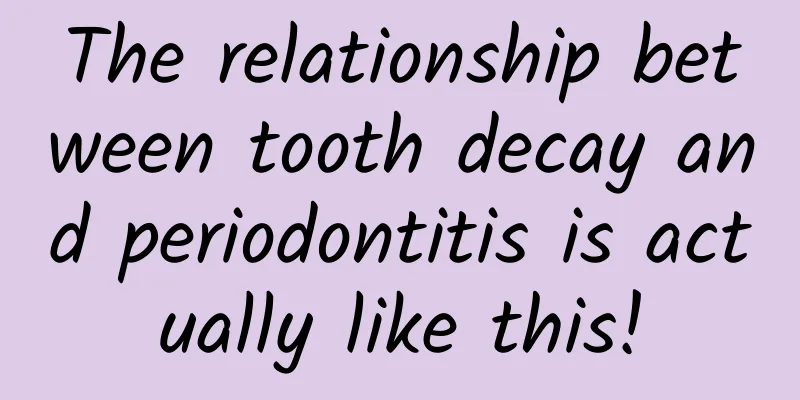The relationship between tooth decay and periodontitis is actually like this!

|
When it comes to tooth decay and periodontitis, many people are familiar with them. After all, these two diseases are indeed two common diseases in the dental department. As two diseases, tooth decay and periodontitis are definitely different, but in fact they also have some "similarities" and even connections. Today we will take a good inventory of what the differences are between tooth decay and periodontitis, and what are the "similarities" and connections. The difference between tooth decay and periodontitis First of all, the site of disease . Tooth decay attacks the teeth themselves, namely the enamel, dentin, cementum and even the pulp (after causing pulp disease, it is no longer called tooth decay, but is called chronic pulpitis, acute pulpitis, etc. depending on the actual situation); periodontitis attacks the supporting tissues around the teeth, such as the gums, alveolar bone, periodontal membrane, etc. The second is the symptoms . The main symptom of tooth decay is the formation of cavities in the teeth. Early tooth decay does not form cavities and generally does not attract attention, so when people discover it, there are usually cavities; the symptoms of periodontitis are mainly bleeding gums, alveolar bone absorption, etc. Similarities between tooth decay and periodontitis Although tooth decay and periodontitis have obvious differences in the location of disease and symptoms, they also have "similarities". First of all, the nature of the disease is that both are infectious diseases. The main difference is that the pathogens (pathogenic microorganisms) of the former are cariogenic bacteria, such as Streptococcus mutans, while the latter are periodontal pathogens, such as Fusobacterium nucleatum. The second is the outcome . The outcome of tooth decay and periodontitis is likely to be the loss of teeth, which can be said to be the same. The reason for tooth loss due to tooth decay is that the teeth themselves are hopeless and cannot be saved; the reason for tooth loss due to periodontitis is that the teeth are "displaced" and therefore cannot be saved. Then there are complications . Tooth decay can easily cause pulpitis, and periodontitis is actually the same. When pulpitis and periodontitis exist at the same time, it becomes a "combined periodontal and pulp disease". At this time, both the periodontal problem and the pulp problem must be solved. The link between tooth decay and periodontitis Tooth decay and periodontal disease are not only different, but also "similar" and related. The main manifestation is that tooth decay and periodontitis are often "contradictory", that is, people who are prone to tooth decay rarely have periodontitis, while people with periodontitis are generally not prone to tooth decay. This may be because there is an antagonistic relationship between caries-causing bacteria and periodontal pathogens. The former causes the oral environment to be acidic, while the latter causes the oral environment to be alkaline. |
>>: What should parents be wary of when facing respiratory infections in children?
Recommend
What are the secrets of pregnancy health?
Health care is a favorite choice for many people ...
What to eat to warm the uterus and drive away the cold
Uterine cold is the name of a disease in traditio...
What are the effects of ovarian cysts?
Ovarian cyst is a very common gynecological disea...
Is it normal to discharge lumps of flesh when expelling lochia?
Having a baby is a happy thing for a family, but ...
What should I do if my menstruation doesn’t stop?
Under normal circumstances, except for women duri...
What to check at 8 weeks of pregnancy
A woman's entire pregnancy lasts about 40 wee...
Do all women have gynecological inflammation?
In our daily life, many girls are confused by som...
Why do women suffer from postpartum depression?
I think everyone has read a lot of news reports a...
I have constipation, what should I eat?
1. These ingredients are good for intestinal heal...
Small fleshy bumps on labia minora
Some women may have such a situation, that is, sm...
The harm of failure of conservative treatment of ectopic pregnancy
Many women do not want to undergo surgery after d...
Lymphoma treatment encyclopedia: a comprehensive explanation from chemotherapy to bone marrow transplantation
Author: Han Bing, Chief Physician, Peking Union M...
What to do if progesterone is low and bleeding occurs
Progesterone, also known as corpus luteum, is a n...
A 1-year-old child had a skull deformity, and the doctor performed precise surgery to remove the "curse" for him!
As the baby grows, parents all hope that their ch...
Can umbilical cord blood save lives at a critical moment? Is there any scientific basis for the saying "give birth to one and save one"?
Following the success of "The World", &...









